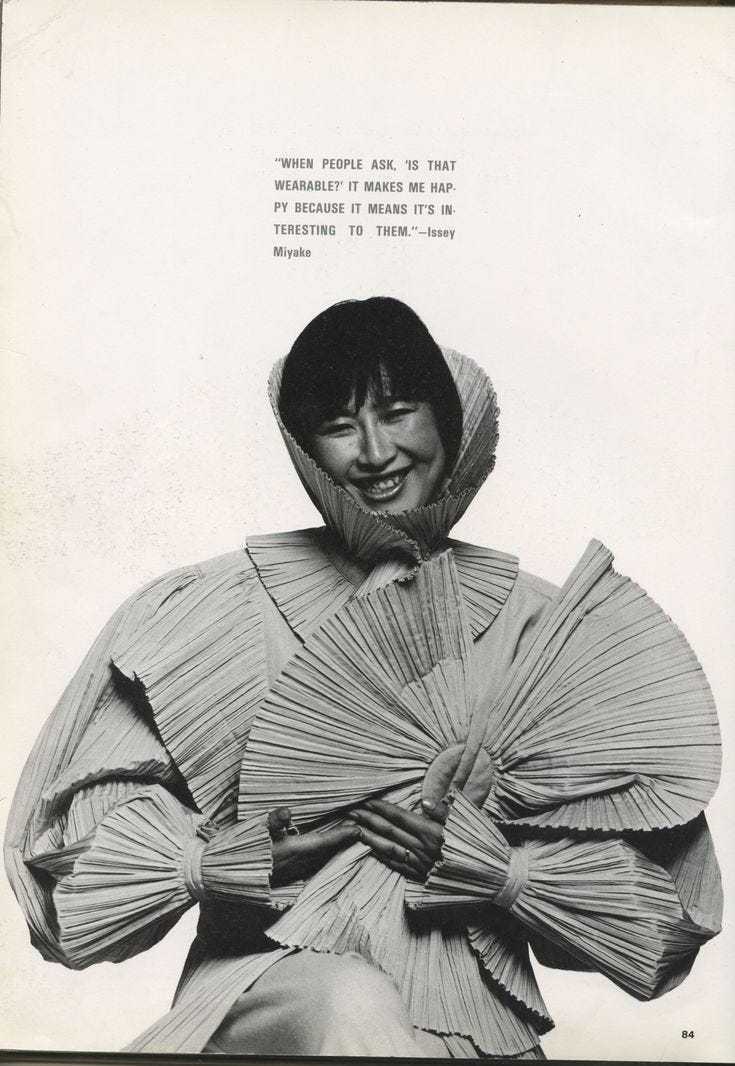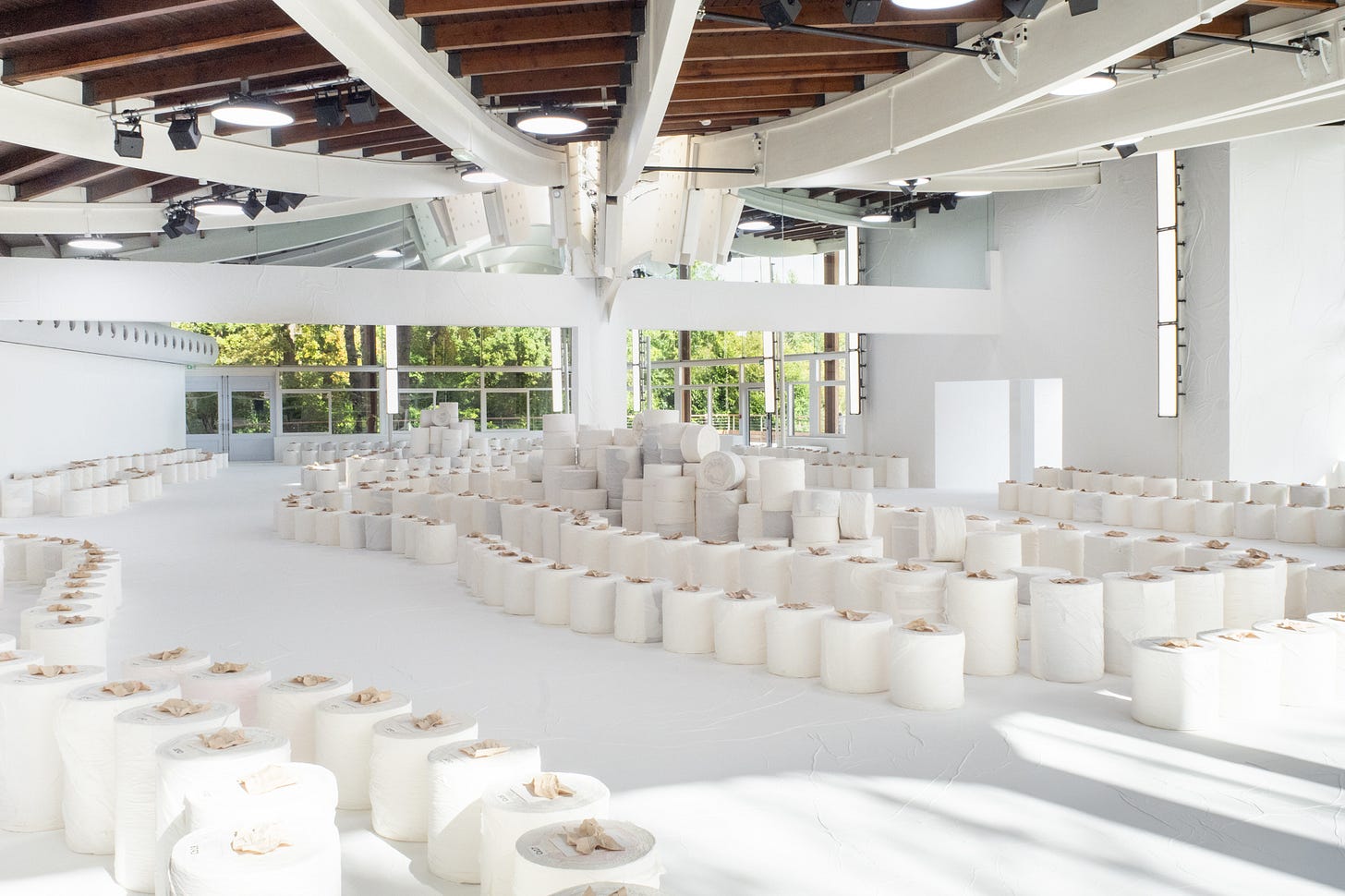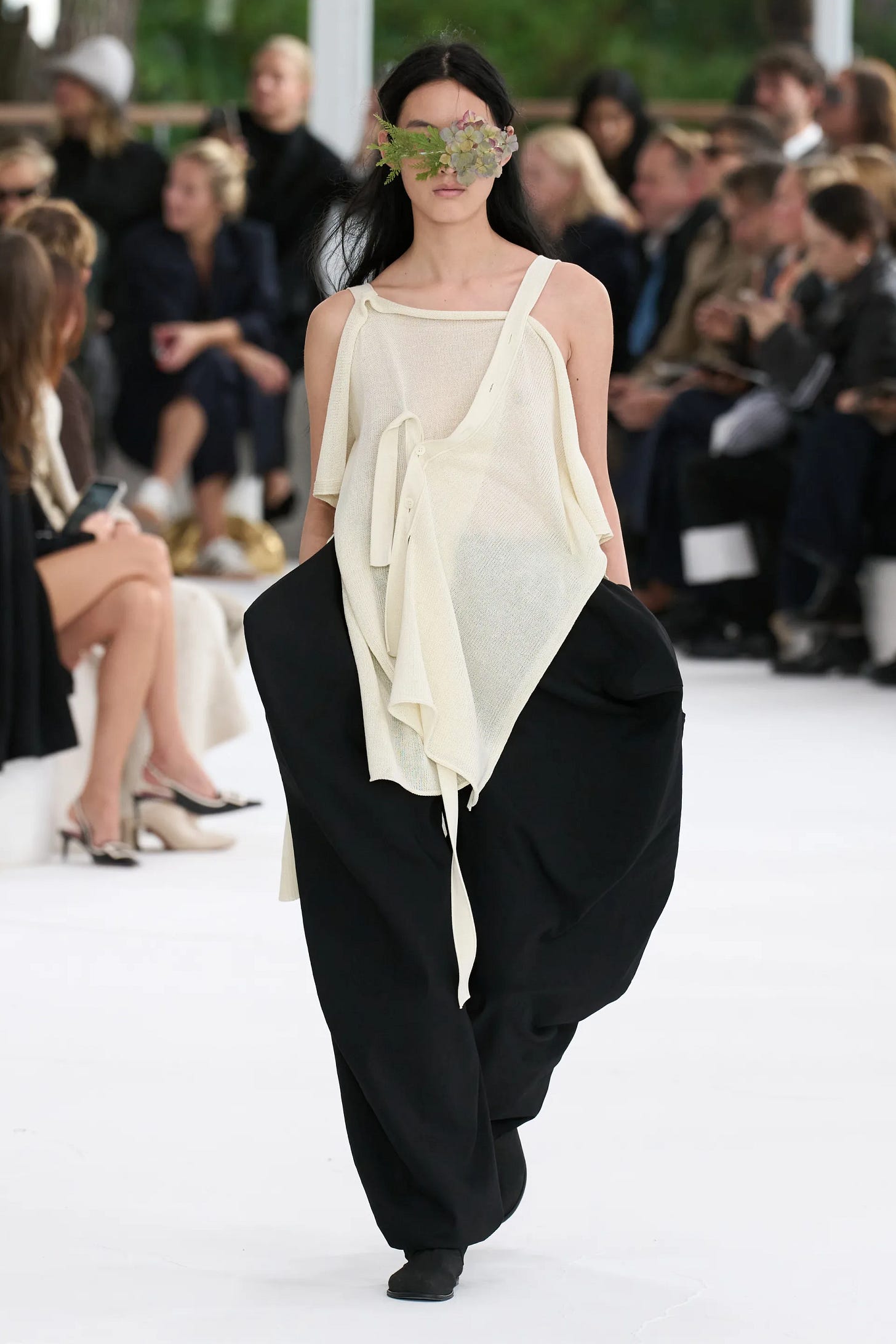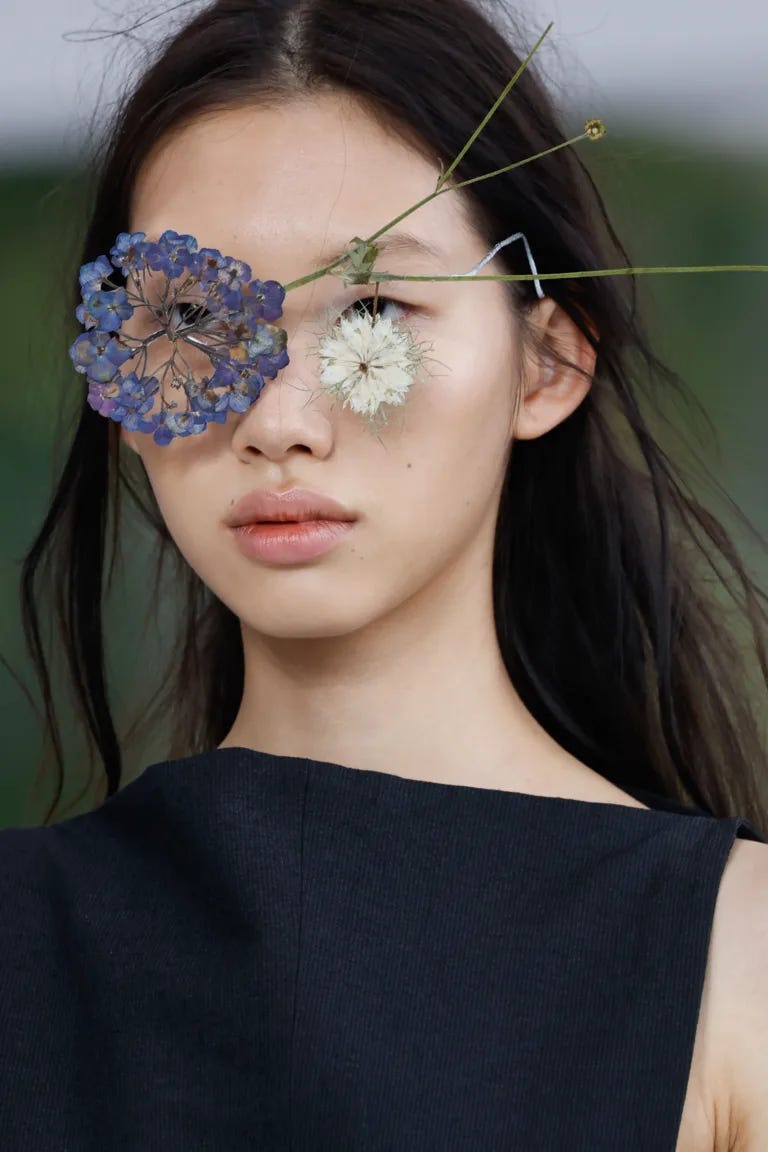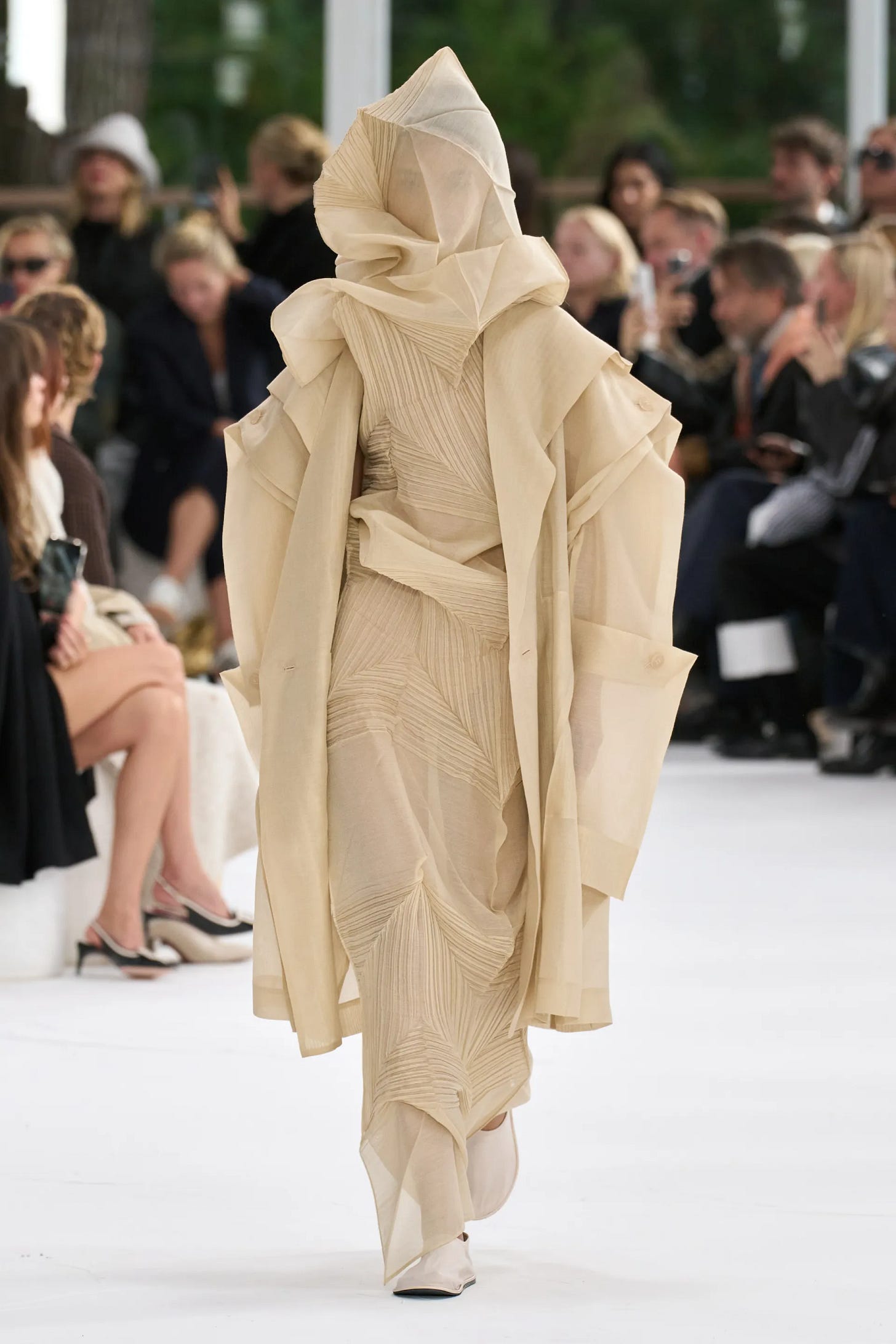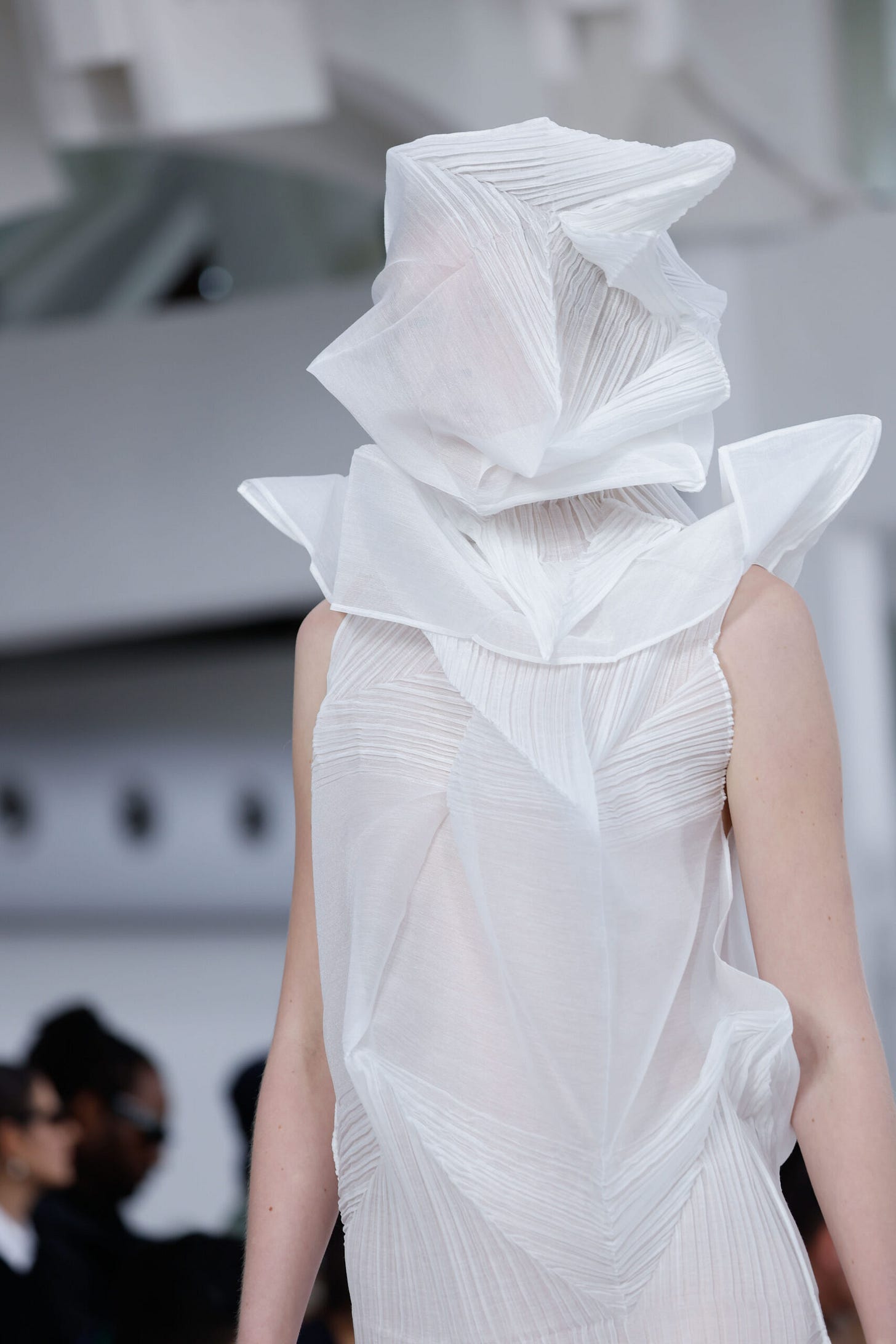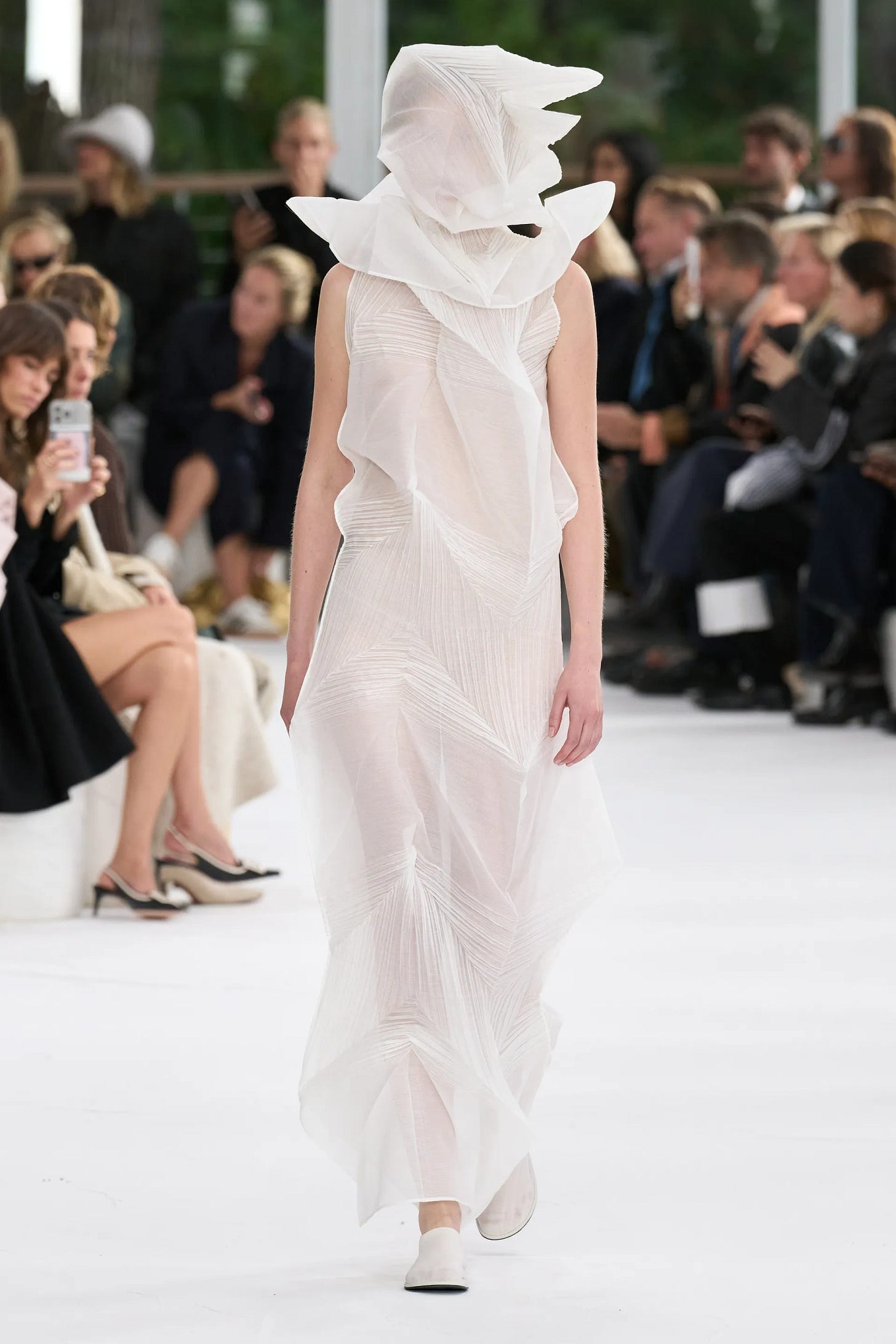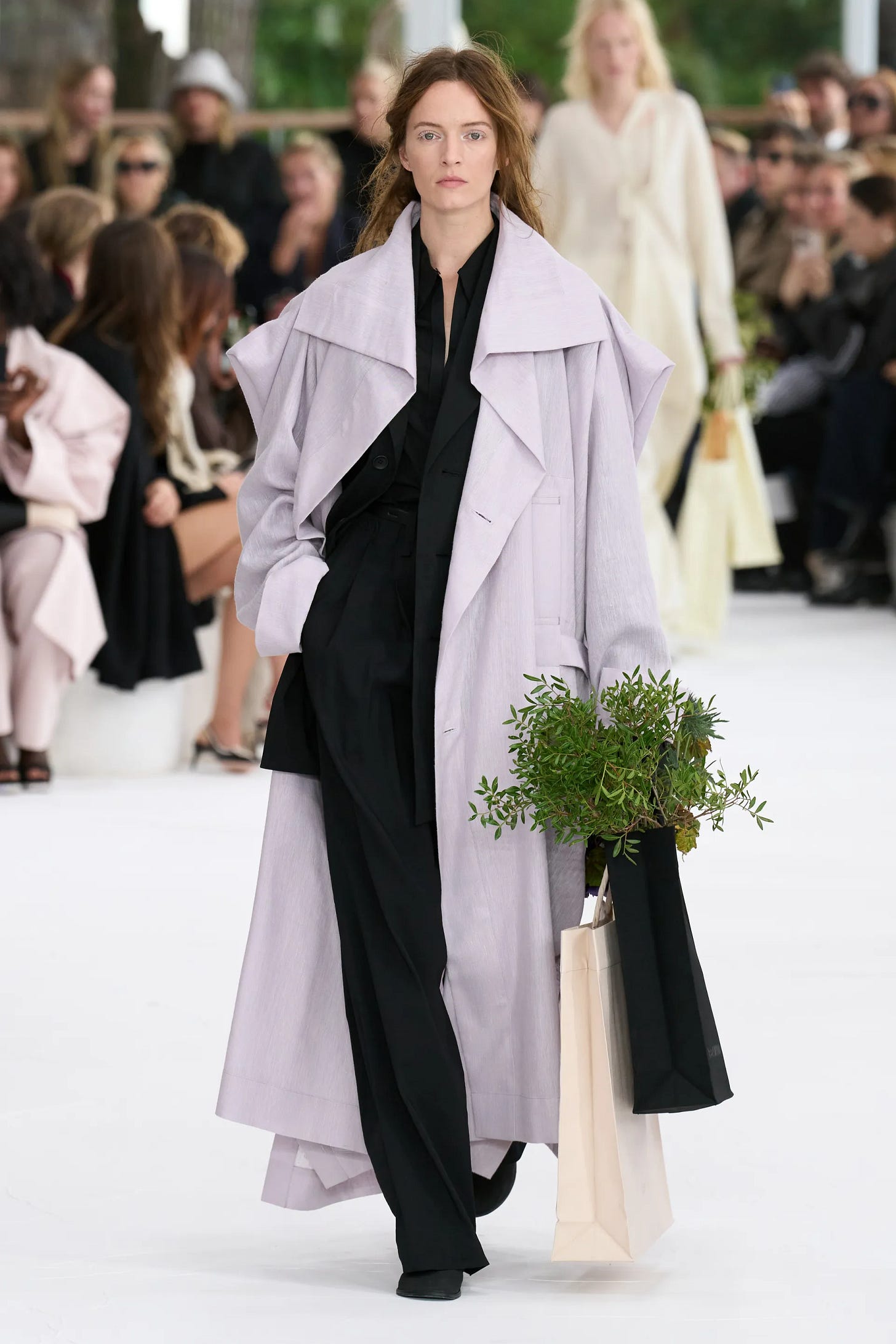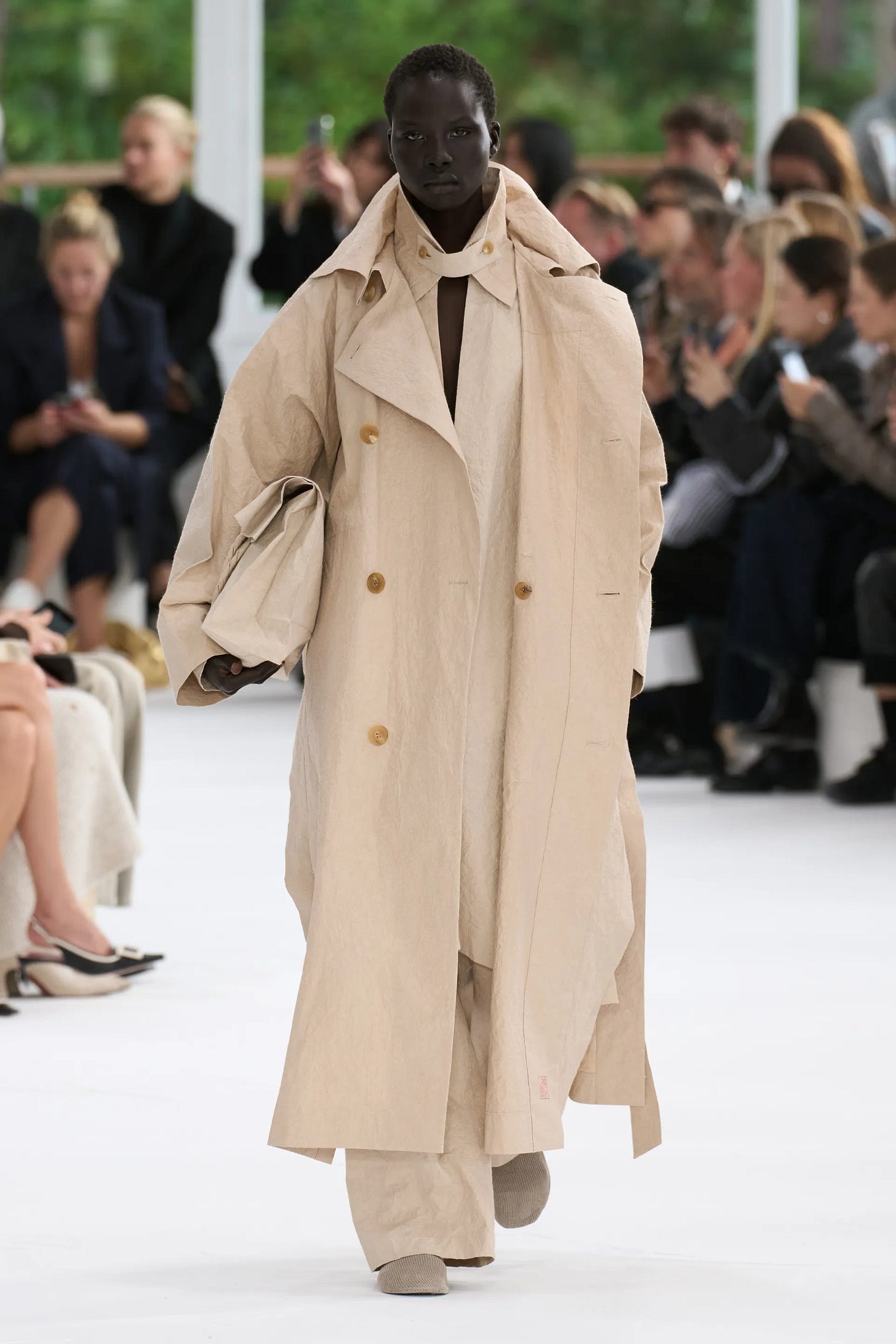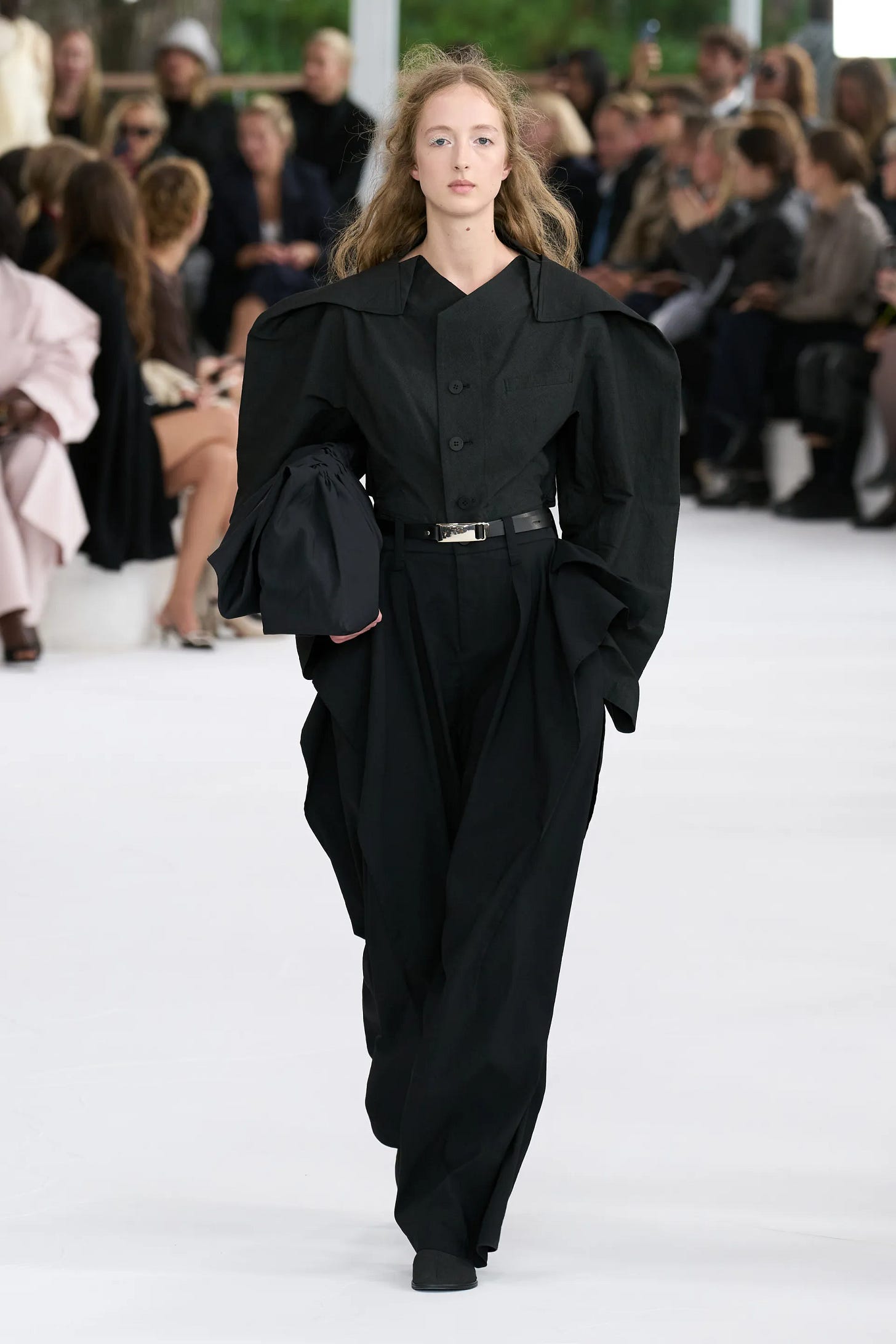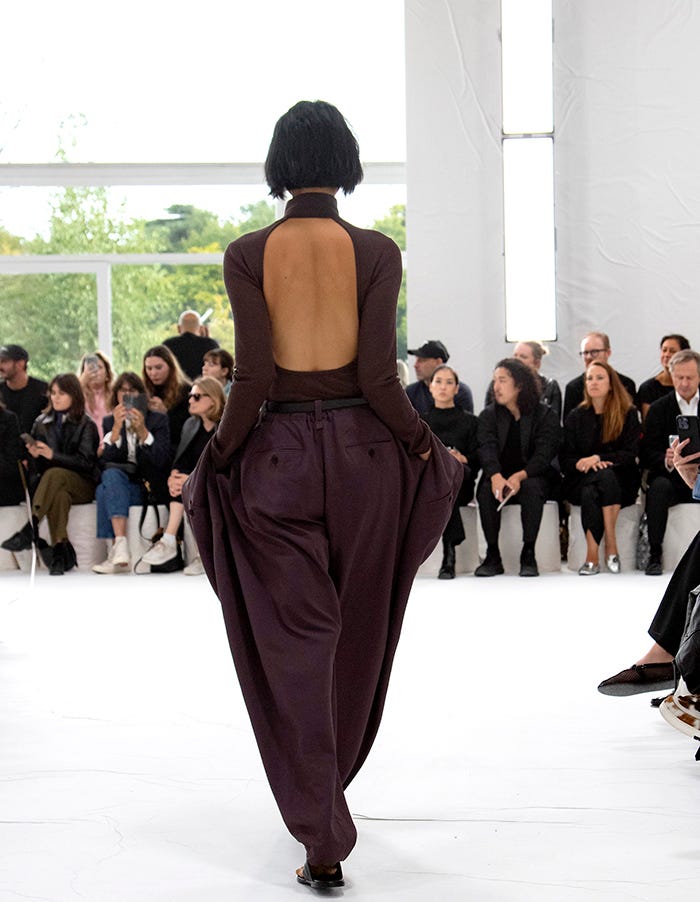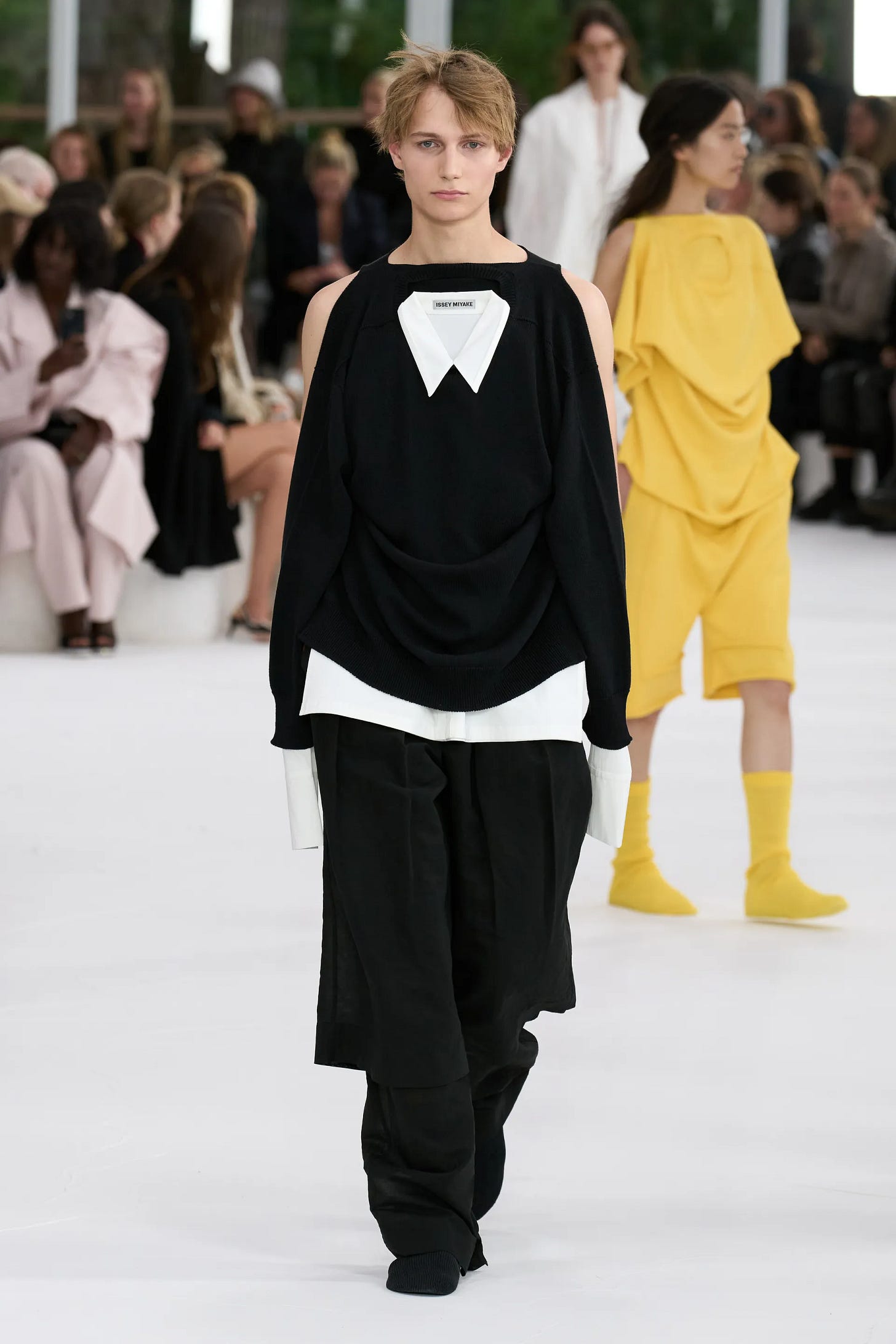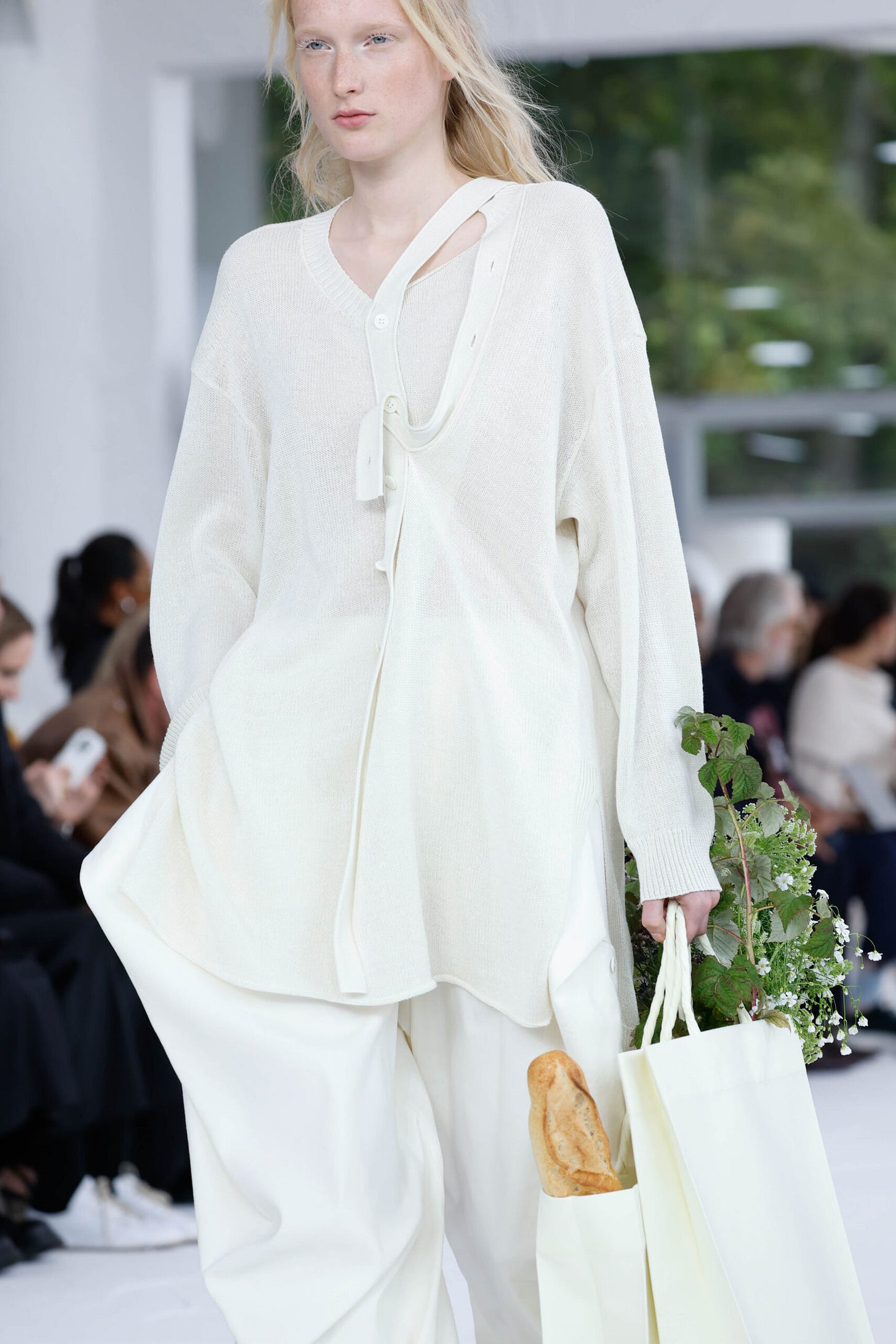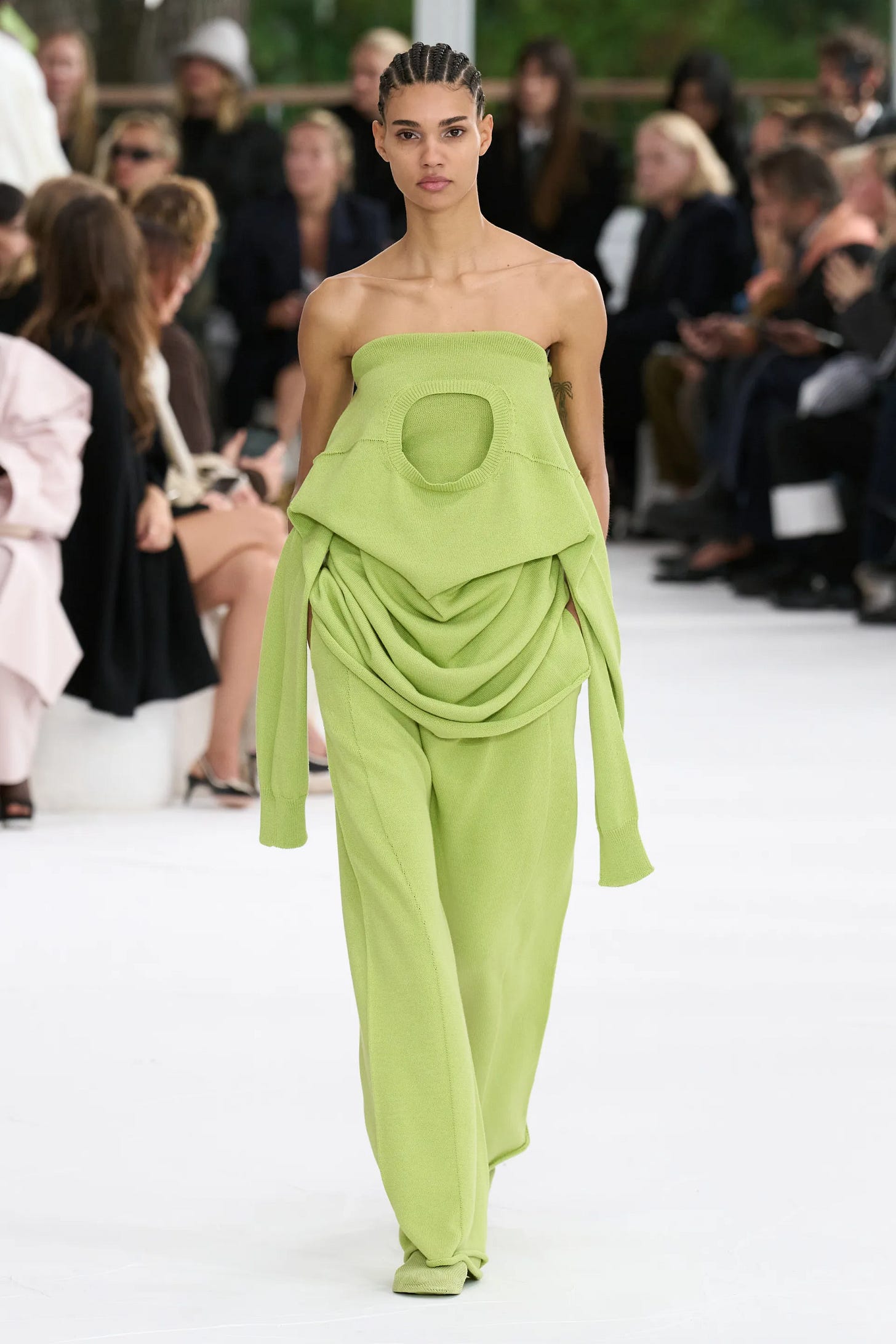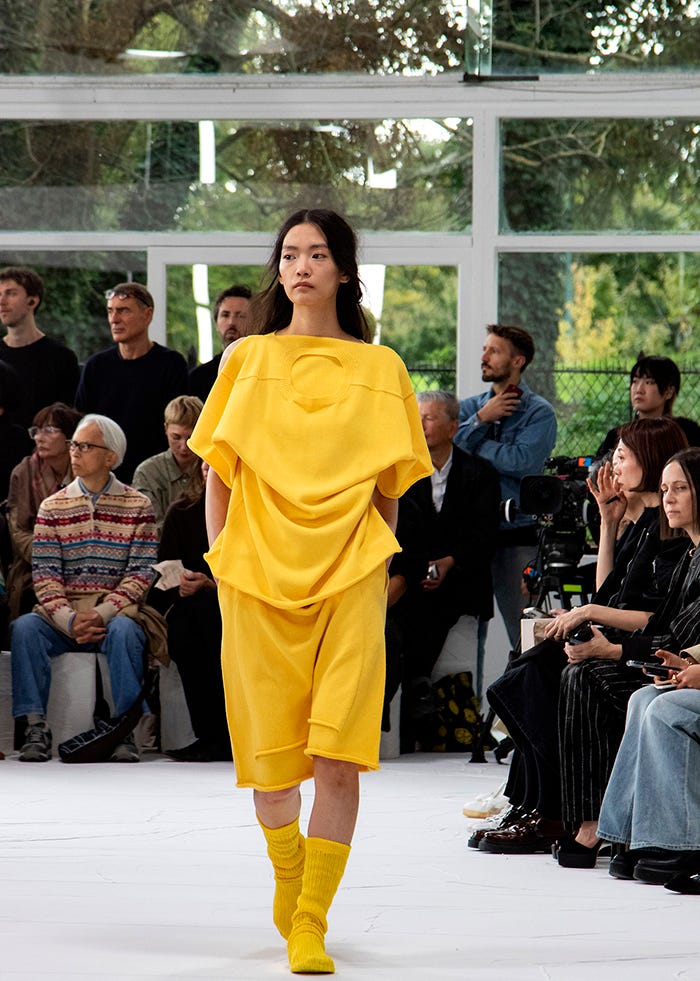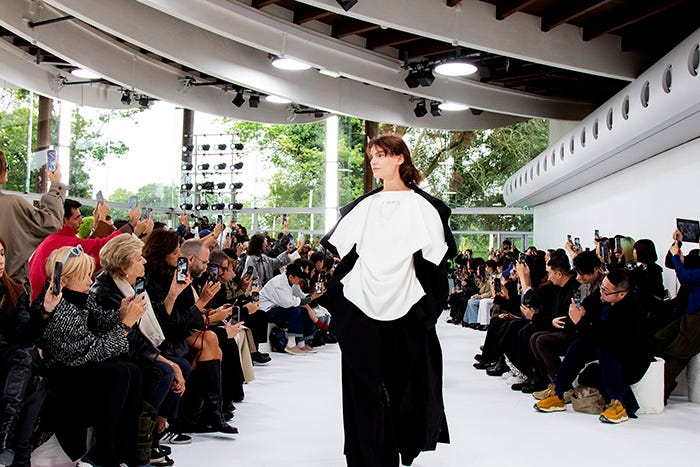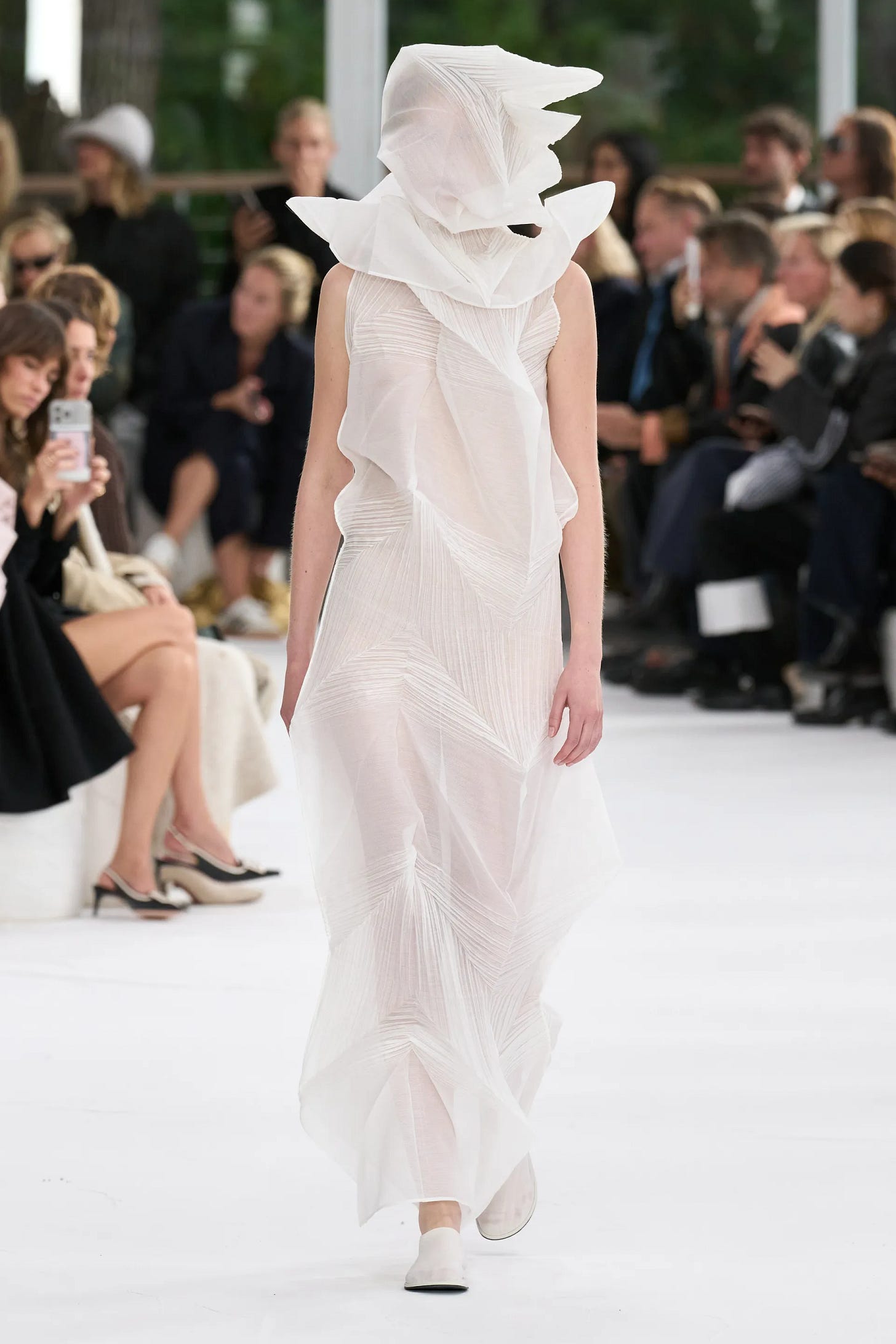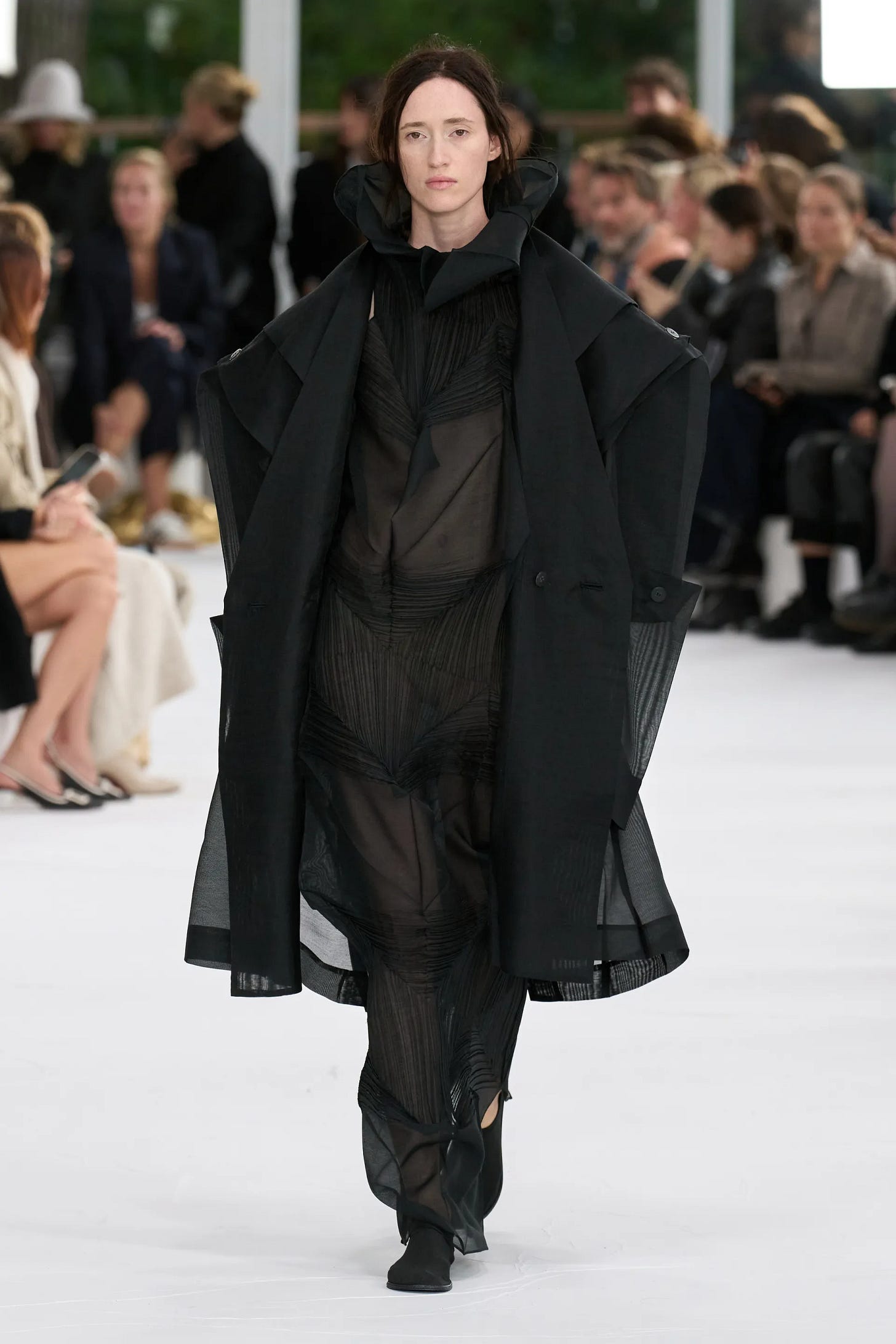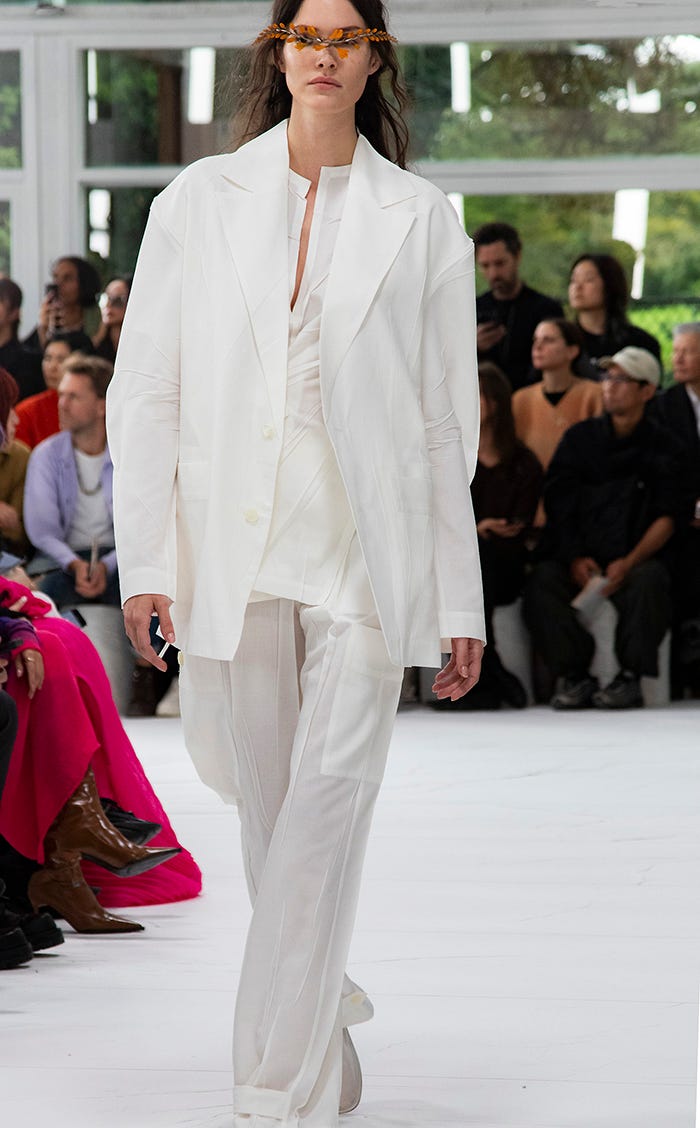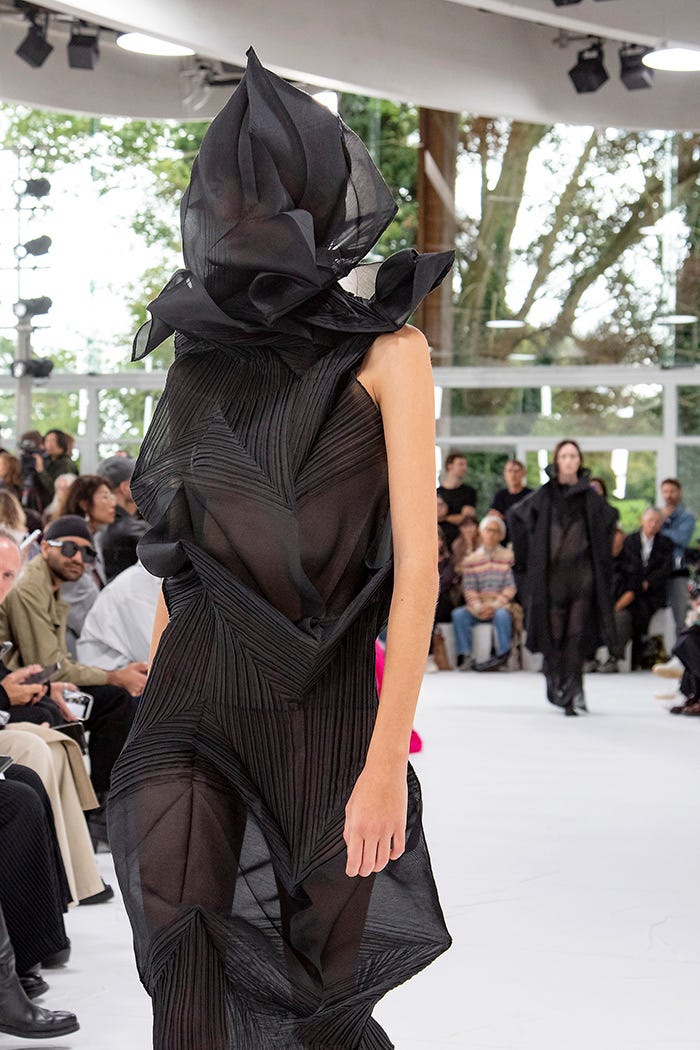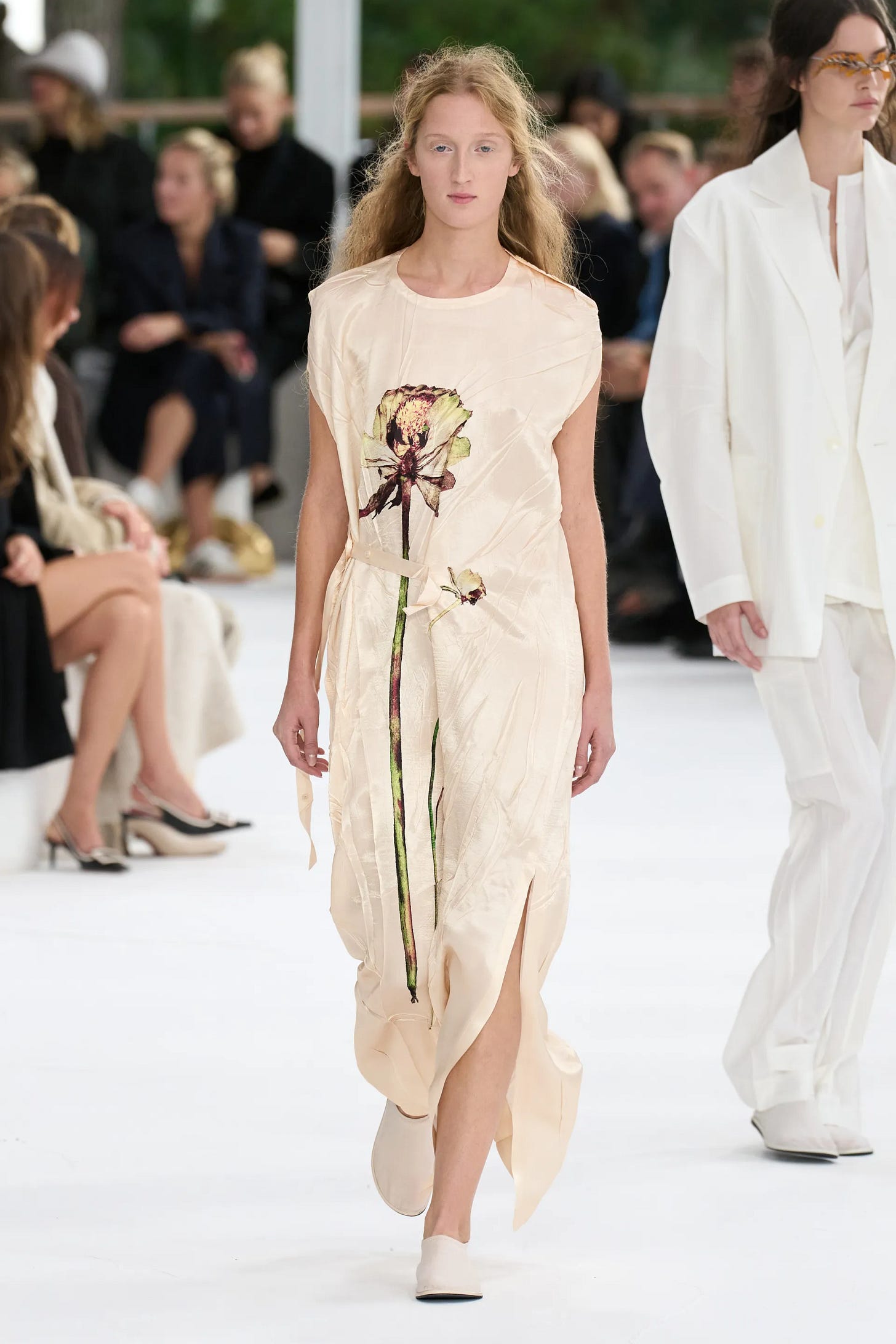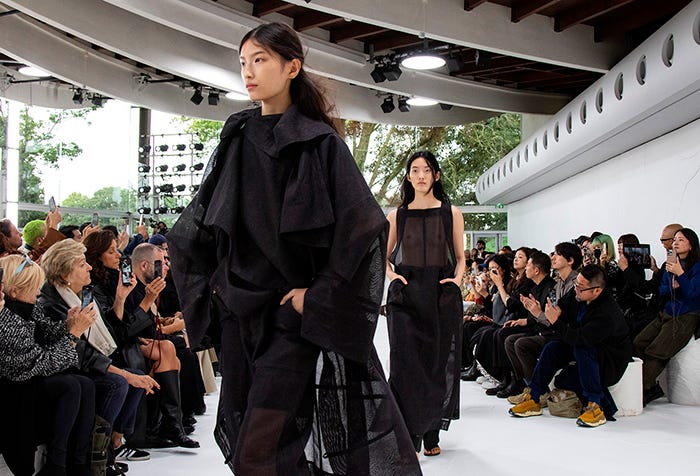ISSEY MIYAKE SS25; AN EXPLORATION INTO THE POETRY OF PAPER
(special shoutout to the most ginormous metallic crocodile clip I've ever seen; to hold up an asymmetrically draped pant, one-sided folded over-panel; the illusion of layered shorts over pants)
For its SS25, ‘The Beauty of Paper’, at Paris’ Parc Floral, Issey Miyake Studios took the opportunity to explore the trenches of the poetry behind paper under the creative direction of Satoshi Kondo. Issey Miyake Studios is a design house that fostered itself by rendering the technicalities of many mediums, especially so, paper, as perhaps its greatest tool. To date, such explorations and creative investigations have inspired the studio’s process of ‘ideation to construction’, tapping into values derived from historical connection and cultural significance. This was seen in the derivation of a whole collection from the cultural significance of the beauty and art entailing the Japanese Washi— a traditional Japanese paper made from plant fibres. “Our exploration into the ancient craft of papermaking uncovered a material rich in cultural meaning and emotional resonance”, said the design team. The making of the collection began with the question, “ What makes paper— something so simple— evoke feelings of purity, comfort, and even nostalgia?” and this led to the extension of 9 sub-branches of explorations of the Washi. The underlying essence behind this question is a theme of the passage of time that speaks of how while our industry is striding hastily and remains ever-changing, the muses and the materials we draw from are all deeply rooted in history.
To delve into a small part of the history of explorations that I keep mentioning, let's talk— obviously so— ‘paper’. This beautiful, omnipresent, tactile material, ‘Paper’, first took its direction under Miyake when he explored a plethora of mediums to create clothes for ‘the many than the few’. The inception of ‘PLEATS PLEASE ISSEY MIYAKE’ marked the foundational importance of the element— paper— that formed the basis for this collection. Miyake, in 1988, started to explore the process of garment pleating— the most famous element that sets Miyake’s creations apart from the first gaze in the industry— through a new perspective, and an even greater curiosity to explore a variety of techniques and materials. He used mere layers of paper and a heat press that created a whole new dimension of the artistry of pleats that we all so admire today. Instead of cutting clothes, sewing them from a pre-pleated fabric and then adding in the pleats, Miyake first cut and sewed precisely oversized garments using a new fibre with memory, that retained the shape once the process was finished. He followed it by sandwiching the oversized fabric between layers of paper and then feeding them into a heat press which shrank them to perfectly sized garments. This exploration proved to be very successful and the result that came out was worth the craze that exists today for Issey Miyake. He created a wide range of pleated clothing by virtue of the newfound process, the fibre medium, and with the further intertwinement of handcrafting and fabric manipulations like folding, twisting, pressing, and crushing the cloth even more.
Satoshi Kondo, with SS25, immersed the runway setting into a dialogue between the past and the present, the material and the creator. The theme of the passage of time woven into the entire collection found its muse in Japanese history while gently tapping into the conundrum of today's fast-paced world. Miyake had always found his muse in intertwining newer technologies with traditional techniques and the historical essences of art— offering excellent functionality but often seen as outdated, like sashiko embroidery, and itajime— for his creations. ‘Issey Miyake has always respected traditional artisans. Merging traditional crafts with what we are doing creates a new way to express the beauty of itajime’, said an anonymous designer at the 132 5 Issey Miyake flagship. Kondo relays the legacy of Issey Miyake just perfectly— showcasing how his role as a creative director aligns harmoniously with the essence that Miyake left behind— while also bringing his individuality more and more with each passing collection.
The show setting was an all-encompassing scenery of recycled cylindrical stools, stacked onto one another and lined up adjoiningly, for the guests to sit on. These stools, being a byproduct of Miyake’s pleating process, mimicked a form of poetry that trees hold in their being— a natural artistry, an inherent beauty, and the ability to form connections, bridge distances between the living and the non-living, and light up a firework of emotions. Cut at the right height from huge piles of such cylinders of compressed paper sheets, the marbling from the centre juxtaposed with that of the insides of a tree trunk— most specifically, the growth rings of a tree. This facet of the collection, brimming with consideration, fell perfectly into the narrative of a passage of time likewise to the entirety of the collection. The hempen seats were a prologue to the extensive collection that encircled an array of looks based on paper.
Models in shrouded and gleaming white looks dawned on the runway as bubbling music of dripping water opened into the void of the setting and broke the drought. These looks, constructed from a semi-transparent sheath with internally tucked draping, gleamed with an aquatic quality resembling paper's dampened side. The models seemed like water nymphs rising from a deep forest, mist-shrouded lake. Honed to perfection, the internally fastened draping created softer edges and bestowed upon ‘The Eau Series’ a fluidity inherent to water. It stood as a corroboration to the duality of paper which can be molded into static models— the paper seats— and simultaneously mimic the ethereality in the fluidity of water.
The next set of looks paid homage to the Japanese Kamiko— a traditional Japanese clothing, which dates back to a millennium, made from washi paper— forming part of the ‘Ease and Eased series’. In hues of beige, white, and black, these pieces were crafted from a mix of washi, silk rayon, shot with hemp yarn, mohair, and wool. The qualities of this textile not only imparted an organic textured feel but helped Satoshi handcraft beautifully detailed silhouettes that held an intricate balance between the angular edges, fold details, and flexibility. Falling effortlessly over the models’ bodies, these looks were a perfect harmony between durability and functionality, the Japanese way of living, their strong beliefs in sustainability and an effortless presence of style.
This was a subset of the broader ‘Hempen series’ that spotted a further exploration into hemp, a fabric that has formed a common thread between the relationship of both paper and clothing in Japan for a long time. The fabric was dyed in warm colours and coated to adapt to the contemporary living style imparting natural lightness and comfort to the dynamic silhouettes. One of the pieces that I was absolutely enthralled with was the voluminous, pleated trousers in a deep plum brown that spotted an exaggerated silhouette at the hips. Another nod to the past and present was the asymmetrical, layered dress in a muted pastel palette with ruchings and draping all across its form. Both of these manipulations were intentional and the folds and creases perhaps symbolised the way aged origami naturally crinkles. To me, the gatherings in the dress also somehow represented a visual of a stack of crinkle-edged paper that had been bundled and stored in a corner of a broken-down mill for a decade. As time perpetually flew through the immateriality of the abandoned stack of paper, and consequently subjected it to a metamorphosis— taking away its original colour. A rustic red and hues of ochre took their place onto the forgotten paper’s pearly white surface, finally turning it into an aged artefact. This further illuminated Miyake’s signature driving force to explore and experiment with the forms and structures of the collection.
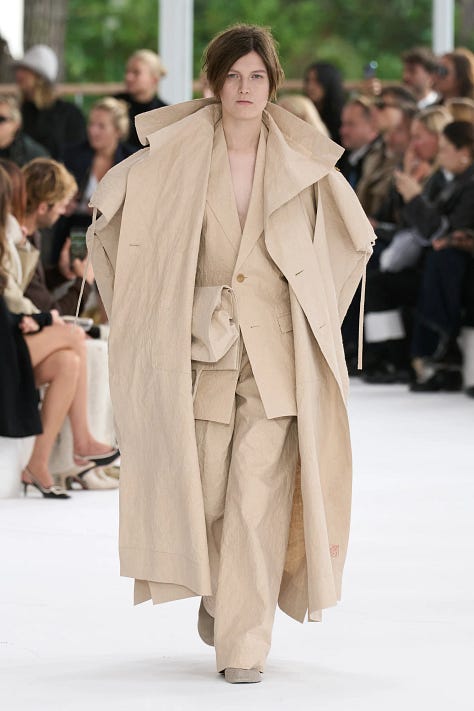

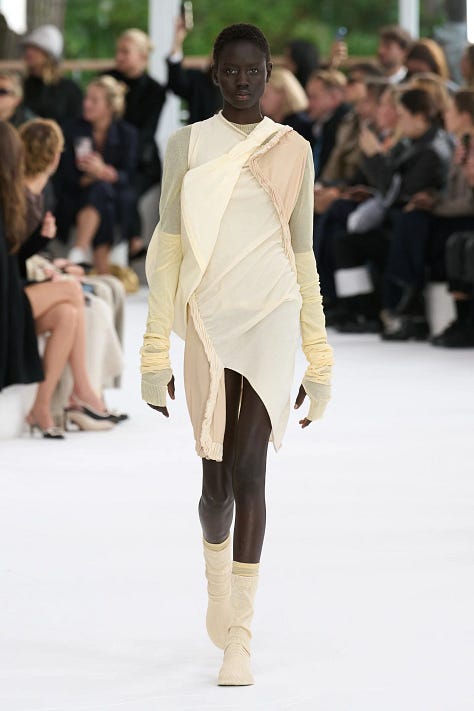
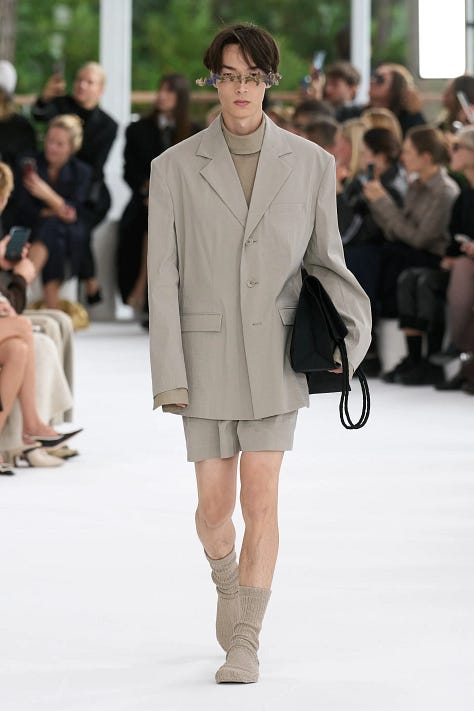

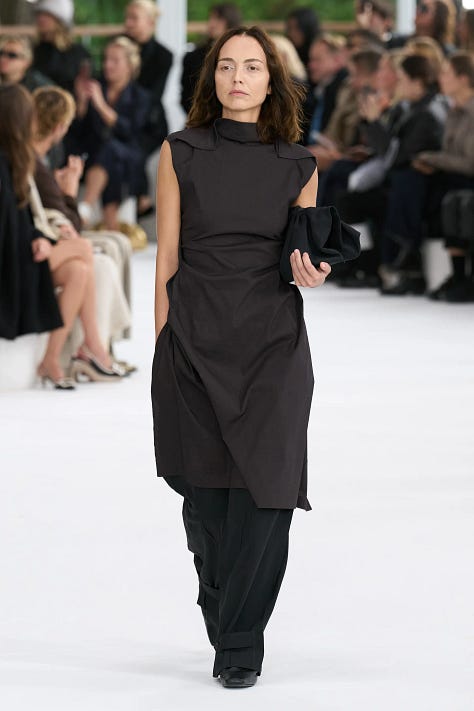
The visual of ‘ink stains on pearly unscathed paper’ found a direct symbolisation with Look 15 under the hempen series that took on an interplay between the elements of contrast. The white, open silhouette trench coat with exaggerated and defined collars fell perfectly onto the sheer, translucent flowing tunic underneath, showcasing an igniting fusion of elegance and grace intertwined with a play of opacity, delicacy, and lightness. The ensemble’s essence was nothing short of a blank slate of potential that was waiting to be inscribed. The pearly white trench and tunic— a metaphor for the impermanence of time and an interplay between lightness and darkness— was paired with voluminous opaque black trousers— symbolising tenacity and stability, just like ink on paper. The design elements beamed with an effortless rawness— that represented to me the Japanese countryside— that harmoniously fit in with the crafted sophistication and demeanour much found in urban settings.
As the collection went forward, the exploration dove into deeper interplays— not just between the hidden essences of the design— between the actual, tangible elements of clothing, encapsulated in the ‘Wear and Worn’ series. This subset was, perhaps, one of the most playful and alterable explorations into the Miyake process. Featuring soft textures and muted, pastel shades, the series spotted a mix of oversized, deconstructed, conceptual asymmetries, and intentional draping and gathering in the tops’ sets— tunics, cardigans and knit tops, collared t-shirts— which was paired with exaggerated silhouettes for the bottoms— wide-legged trousers, draped pleated shorts, and wide hipped pants. These garments could be worn in any of the ways imaginable by the human mind, you name it and you have yourself a completely new garment in just seconds. By utilising seamless knitting technology, Kondo created various avenues for the garments to be interlocked, passed through one another, or even reversed. If we look at it from a logical point of view, we need many more variations of such clothing and a dire need to intertwine versatility in our daily fashion choices due to the looming climate crisis above our heads and an ever-increasing obsession to don newer outfit pairings all the time. By now, we can lay in stone the fact that the Japanese have been finding their muse in nature and their ethos in protecting it for centuries for almost all their creations— and this collection was a byproduct of the congregation of the greatest heirloom the Japanese could pass down to the world.
One of the people who I exceptionally need to mention is Maiko Takeda— an accessory designer who graduated from CSM— and her surrealistic eye and headwear creations for the studios. Her work revolves around exploring tangible and mundane entities and transforming them into ethereal and surrealistic experiences. Her creations popped up the entirety of the collection. They blended in flawlessly the harmony of intricate craftsmanship that Kondo produced with elements of surrealism that emanated from the floral shades and a wide-brimmed hat. The sophistication in the construction of the botany-inspired shades made it seem like they were suspended in the air around the models’ heads— something straight out of Japanese fantasy media. In the hues of muted purples, pinks, powder yellow, sage greens, and hints of periwinkle, the shades stood both as a testament to the transience of nature frozen in the moment and as a bridge that connects the contrary yet complimentary aspects of our world— the ephemerals, nature and time, and the enduring, fashion and art. Not forgetting the ‘paper bags’— brimming with flowers, plants, and baguettes— that the models carried with them, we have ourselves yet another one of Miyake’s sub-subset series. The bags were, most obviously, inspired by the customary paper shopping bags but since it's a Miyake creation it has a few notches attached to it. The element of utility was rampant in their creation owed to the special blend of woven yarns made from washi flakes for the body’s construction and the addition of corded handles for durability. These items of baggage exemplified the intersection of art and utility, a dogma set in process by Miyake.
The ISSEY MIYAKE ‘meticulous attention to detail’ phenomenon flowed throughout the collection, especially finding its headwater in the ‘Cloth and Cord’ series. The constituents of this subset meditated upon Miyake’s mastery of fluidity and form, creating an interplay between structure and softness, and refinement and organicness. The pieces were constructed in uncut fabric that was essentially made from a blend of linen and stretch yarns, skillfully woven into a soft, pliable material. This offered lightness and an airy, dynamic texture to the looks. The voluminous, flowing fabric was held on by cotton rope laces from the neck, creating effortless gathers and drapes around the neckline that further cascaded down loosely to the waist. The cinched draping at the waist with the tied knot belts added structure to the otherwise relaxed silhouette. Such details accentuated the organic essence of the looks and highlighted the artisanal details rendered in the construction process. The billowing bottoms— wide trousers with tapering at the ankles in the form of gathers— added another layer of monasticness and a sense of continuity to the overall essence of these looks. The effortless gathers, draping, and rope details exuded a sense of fluidity inherent in cyclical waves of energy, and cultivation of simplicity and transcendence preached about at monasteries. These pieces in hues of beiges and browns, while having a laidback vibe to them, held an innate rustic craft with utmost sophistication in their construction.
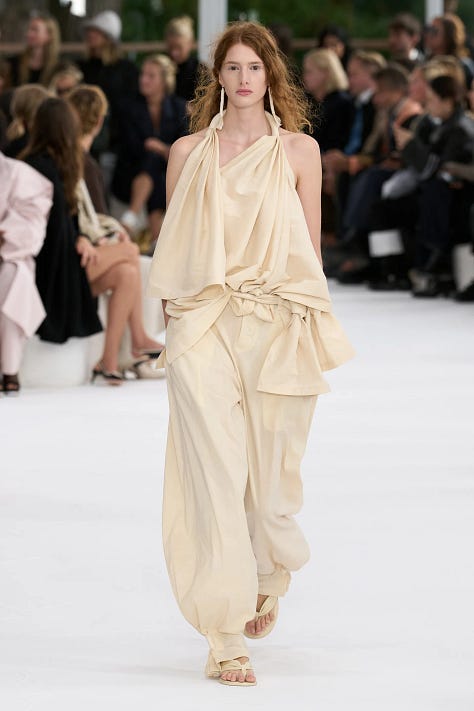
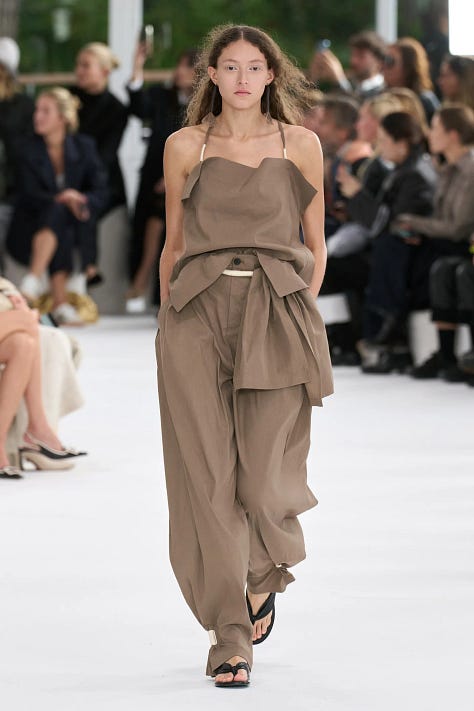

Satoshi Kondo also found his muse in the Japanese craft form of origami, whose roots go deep in paper. The avant-garde pieces showcased three-dimensional silhouettes that played between the paradox of both, the angular edges and the soft, light sculptural forms. The creations used a blend of washi and rayon flakes that bestowed upon the fabric the ability to form box-like compartments and pleats while being shrouded in light, airy drapery. Satoshi’s explorations manifest their way into the construction process most innovatively and ingeniously and the ‘Fold to Form’ series marked this achievement much conspicuously. These pieces were impeccably brought to existence to be worn in the Sci-Fi award-winning movie series, Dune. An extension of this exploration was seen in the ‘Shade and Shaded’ series, wherein Kondo used the same fabric to traverse into the drama between the themes that encapsulated the origin of the collection— light and shadow, transparency and opacity. The sheer fabric was partially folded in various places— giving both, sharp edges and soft drapes, cocooning over the body in the most elemental ways— and pleated diagonally, vertically, and horizontally. Such manipulations gave way to the emergence of translucence and obscurity, symbolising the dual nature of paper.
One of my favourite series for Miyake SS25, which I haven't yet mentioned, was the ‘Pressed Flora’ series. The satin-like, glossy and light fabric for the pieces with the pressed floral prints of delicate spring flowers— peonies and ranunculouses— throughout the body, invoked an essence of the softest femininity possible. The prints were made to seem as if they were flowers long preserved midst the pages of a book, dried and flattened but just as beautiful as they were when they brimmed with life. Call it a bias for these three looks to be my favourite— since I collect flowers and throw them, but delicately, into the side zipper of my college bag until it bursts and a new batch of florals pave its way in eventually to be dried up— but the crinkles and creasings across the fabric due to the pressing process perfectly mimicked the natural preservation of the flora. Describing the attention to detail at Miyake Studios as a ‘phenomenon’ is most surrealistically justified. We spotted a loose-fitted, short-sleeved blouse with a button belt to cinch the waist on one side that was paired with a flowing, long skirt with a subtle slit. This created a cohesive, continual flow of pattern that accentuated the ethereality of the garment. The seamlessness in the construction added to the soft feminine sensualities of the looks. The bright prints of florals emphasised the fleeting vibrancy of flowers while the resulting creasing effects gave the pieces an archival quality. The exploration into textiles and the natural preservation of beauty voiced the depth behind the transcience and intricate delicateness of the flowers— much like paper.
“We wanted to rediscover the connection between people and paper,” the design team shared. Once the millennium-old connection was found, inspiration and manifestation found their way to materialisation through a wide array of textures and process explorations. Issey Miyake SS25 was like a beach shore, where the gleaming water meets the textured sand and sensuousness abounds, of an island yet to be explored. Satoshi Kondo conveyed the bounds of poetry inherent to paper in a contemporary relevance, and simultaneously in a manner that set in motion an archetypal cinematography of paper’s historical relationship and integration with the human society. He conveyed Miyake’s tenets with an effortless fusion of his own creative morphings— Miyake’s distinctive pleats with Kondo’s blend of dynamics and movement— in the form of design conceptuality that wasn't seen at the brand before. This marks how the brand is ever-evolving and changing in the most exhilarating and unprecedented ways. The collection was a sheer materialisation of how we can thrive in a contemporary setting while respecting and drawing from the traditions that formed us. Satoshi Kondo, with SS25, encouraged us to slow down in a world that never stops, reflect on our innermost thoughts, and find beauty in the meagrest things that surround us.
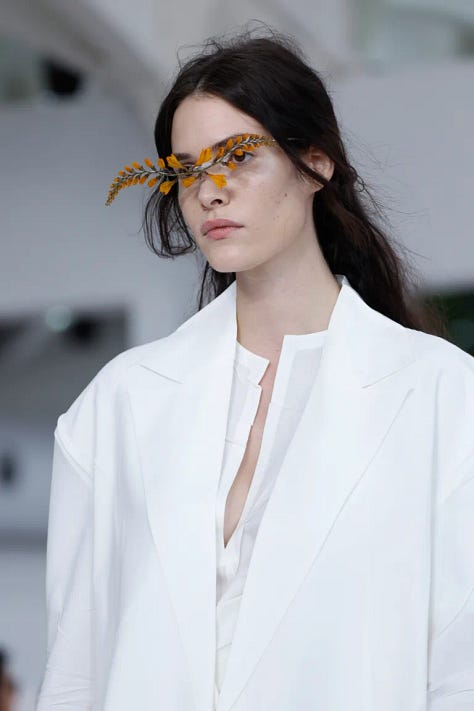
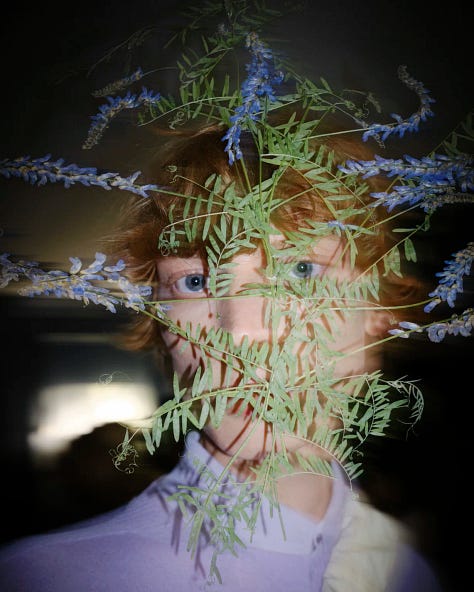
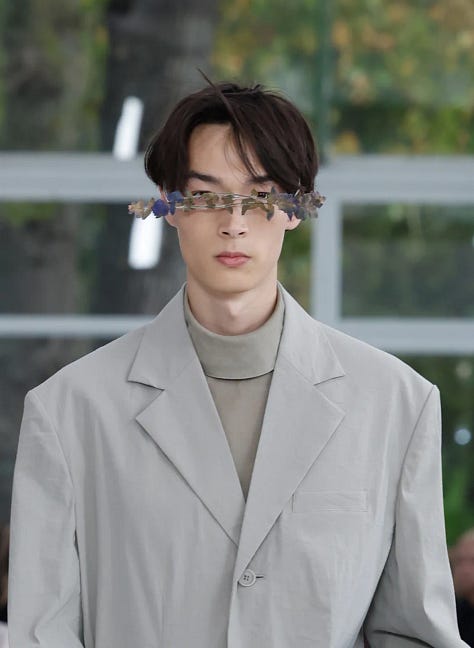
photo credits; photograph by Elli Ioannou for DAM, and Filippo Fior for vogue runway




